Spring is arguably the best time of year for fly fishing. The reason is that there are more insects hatching on the rivers and streams than any other time. The smart fly fisher knows this and comes to the water prepared. Here are the insects we watch for on the tailwaters and streams in the Smoky Mountains.
Tailwater Hatches
It’s relatively easy to prepare for hatches on the tailwaters since there are relatively few bug species. Midges are the most prevalent insect on the large rivers. While they are tiny, about #18 to #24 and sometimes smaller, they are often the most important food item for trout. A fish may eat upwards of a thousand on days with long emergences.
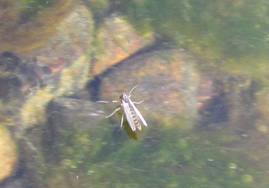
Dry flies like a Griffith’s Gnat can work, but the most successful midge patterns represent larva or pupa. Flies like a Zebra Midge are among the most effective, even when trout are rising. Many trout rising to midges are eating insects just under the surface, but this activity still creates a rise ring.
The most important insect to fly fishers on the tailwaters in the spring is the Sulphur. These elegant mayflies begin to appear in April on most of the tailwaters. They generally peak in May on the Clinch, but late June into July is typically the peak on the South Holston.
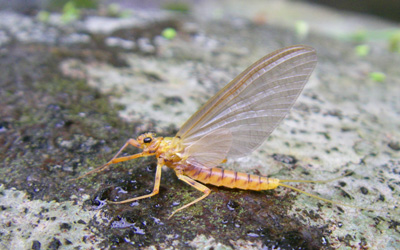
Sulphurs are generally a #16 and a variety of fly patterns will imitate them successfully. A Pheasant Tail nymph is the most popular nymph pattern and it can be used in the hours before the hatch or during the hatch.
Parachute patterns can be effective, but flies without hackle like Compara Duns and Sparkle Duns seem to fool more trout in the smooth, slick currents found on the tailwaters.
Smoky Mountain Hatches
There is far more insect diversity in the mountain streams than there is on the tailwaters. There are literally hundreds of mayfly and caddis species in the Smokies. However, there are only a few insects that you need to focus on.
The first insects to show up may do so even in January. The Little Winter Stonefly is quite small and of marginal importance. They migrate to the banks and crawl out of the water to hatch. While the trout will eat them, they tend to keep themselves out of imminent danger by staying near the banks. These bugs are small, about #18-20, but very tough. We’ve even seen them crawling around on snow along the stream.
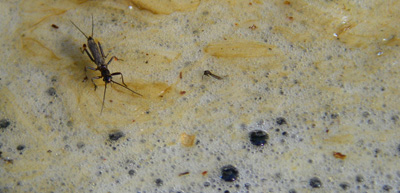
Little Winter Stonefly
The Early Brown Stonefly is a larger cousin of the Little Winter Stonefly. We see these guys buzzing about the streams in March and early April, but trout are only occasionally interested in them. As with all stoneflies, trout are most interested in them when they are laying eggs on the water. Early Brown Stones are #12-14 and cause quite a commotion as the fly about and dive bomb the water to lay their eggs.
A good strategy is to use an Orange Stimulator and drop a nymph under it to imitate emerging mayflies.
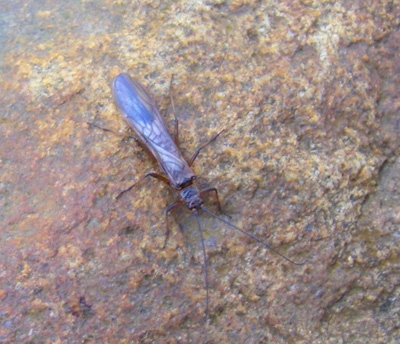
Early Brown Stonefly
Little Black Caddis also emerge relatively early. While these insects rarely cause trout to rise reliably in the Smokies, they do work trout into a frenzy on the Watauga. In the Smokies we begin to see them in February, but they’ll continue to emerge through the spring.
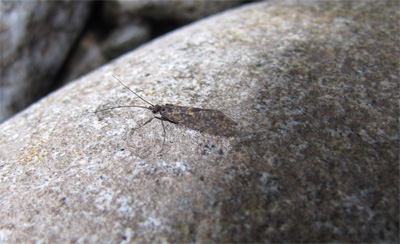
Little Black Caddis
Like the stoneflies, these caddis tend to hatch along the edges of the stream. However, they do get in the water when the lay eggs. Small Elk Hair Caddis in #18 can bring trout to the surface, but wet flies and nymphs seem to be more consistent. This is probably because these bugs hatch when water temperatures are pretty cold and their emergences are scattered and inconsistent on the streams.
Perhaps the two most important insects to the Smoky Mountain fly fisher in the spring are the Quill Gordon and Blue Quill. We’ll go ahead and include the Blue Wing Olive as well, but most people can’t tell them apart from a Blue Quill. It’s very possible the trout don’t distinguish between them either since a fly pattern that works for one will also work for the other.
-
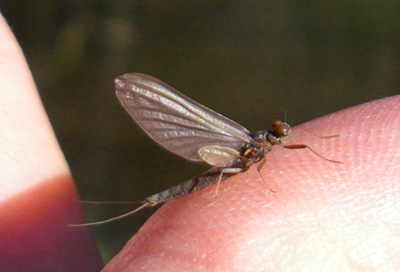
Blue Quills and Blue Wing Olives are small but important to trout and fly fishers
The Blue Wing Olive is also very important on the South Holston and Hiwasse tailwaters. They hatch through the winter and well into the spring on these large rivers.
The Quill Gordon is a large #12 mayfly that has a gray body and wings. They seem somewhat clumsy on the water and their large size and habit of flopping on the surface can put trout into a frenzy.
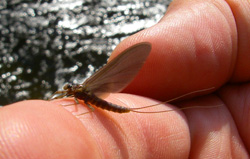
A Quill Gordon
This is our favorite hatch in the Smokies. Every year we’ll find at least one large brown trout up eating these spring time delicacies.
Basic nymph patterns will fool the trout, but an important piece of knowledge is to know that Quill Gordons hatch under water and ascend to the surface with the their wings already out. This means that wet fly patterns are also effective.
For many fly fishers the Yellow Sally or Little Yellow Stonefly is the epitome of Smoky Mountain fly fishing. This perhaps the most consistent and largest emergence of insects every season in the Smokies. We begin to see the Yellow Sally in early to mid April, but it’s late April into May when things really heat up.
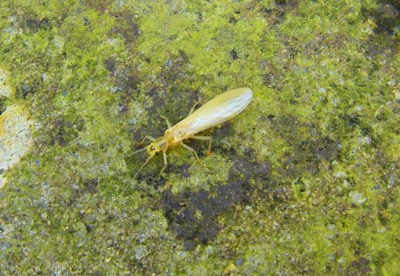
Yellow Sally
The most important thing a fly fisher can do is notice how the insects are flying around the water. If they are flying upwards, there isn’t much use in using a dry fly to imitate them. They emerged from the water to hatch some time ago and are now flying to the safety of streamside vegetation. In fact, this means you should have been fishing a nymph about two or three hours ago.
Things will get crazy when you see the Yellow Sallies flying down to the water. This means they are laying eggs and many will die on the water or drown while laying eggs. This manna from Heaven brings the trout to the surface in a chaotic frenzy. Watch for the Yellow Sallies to emerge and lay eggs around dusk. The action usually only lasts for about 30 minutes, but there’s nothing like it in the Smokies.


Gordon Bruce says
As a beginner, I have learned so much from from you on line info, GREAT INFO!! thanks!
Ken Sperry says
Great post Ian!
Rick Robnett says
Great info and pictures,which mean so much to a novice like me,thanks very much Ian.
Keith says
I enjoy your newsletters, especially this one. As a new struggling angler in WNC, the match the hatch is intriguing.
Thanks for the hints and up-dates.